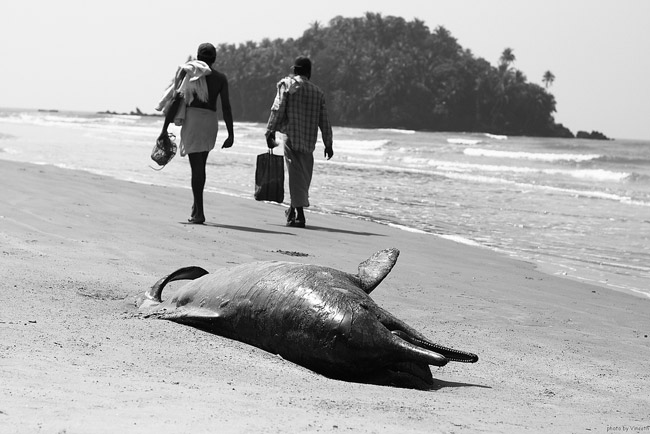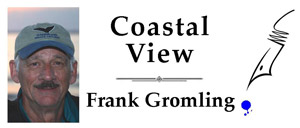
Last Wednesday I spent eight hours at Marineland Dolphin Adventure as part of a brainstorming session with some 19 others for the Flagler County Tourist Development Council, which is working on its next strategic plan. Seated across from the windows overlooking the dolphin tanks, I often was distracted by dolphins leaping high in the air in a balletic display of grace and strength. Watching the dolphins, I decided to change this week’s column to focus on these amazing cetaceans.
Amazing, and the victims of mysterious, massive die-offs in some seas.
 Living on a barrier island gives me frequent opportunities to see dolphins in the wild. Every time I do, I smile outwardly and inwardly. I connect with dolphins in a special way. Years ago in the Florida Keys I was snorkeling in an ocean lagoon with two adolescent bottlenose dolphins when they started to do everything I did. I somersaulted under the surface and so did they. I swam in a corkscrew motion and they did, too. This went on for long minutes as they watched me intently, duplicating my underwater gyrations, until finally they swam off into the blue. I’ll never forget the feelings I had as I left their watery environment for dry land.
Living on a barrier island gives me frequent opportunities to see dolphins in the wild. Every time I do, I smile outwardly and inwardly. I connect with dolphins in a special way. Years ago in the Florida Keys I was snorkeling in an ocean lagoon with two adolescent bottlenose dolphins when they started to do everything I did. I somersaulted under the surface and so did they. I swam in a corkscrew motion and they did, too. This went on for long minutes as they watched me intently, duplicating my underwater gyrations, until finally they swam off into the blue. I’ll never forget the feelings I had as I left their watery environment for dry land.
Years later, I don’t think it is a surprise that two of the foremost dolphin experts on the Atlantic Coast are my friends. Hardy Jones and Steve McCulloch have dedicated their lives to the study and protection of dolphins. Hardy, founder and executive director of BlueVoice.org is an award-winning filmmaker and dolphin expert recognized on a global level as “The Dolphin Defender.” His book, The Voice of the Dolphins, is a popular and personal look into Hardy’s lifelong work to understand and protect dolphins. Steve McCulloch, of Harbor Branch Oceanographic Institution in Fort Pierce, Florida, is a leading dolphin researcher in Florida’s Indian River Lagoon and Atlantic Ocean.
Although my change of column subject late in the week shortened my research and writing time, I was fortunate to reach Hardy Jones for a telephone interview. While talking with Hardy I made another change to my column. Originally intending to write about serious illnesses found in both Atlantic bottlenose and spotted dolphins, Hardy told me something that forced a complete re-write.
He said he recently returned from Peru where he had gone to research why dolphins were showing up dead along the country’s Pacific Coast. Hardy had heard about dolphin die-offs in Peru and decided to look into the problem for himself. Partnering with Peruvian veterinarian and marine mammal expert Dr. Carlos Yaipen-Llanos, he began a survey along the coast and, to his shock and dismay, counted 615 dead dolphins in less than 100 miles. See the video below.
Yaipen-Llanos, whose dolphin rescue operation O.R.C.A. has saved countless dolphins and other marine mammals, determined that dead dolphins he inspected had broken periotic bones (those are the bones that surround the ears of mammals). I asked Hardy how that could happen and his answer surprised me. He said that Yaipen-Llanos believes that underwater seismic testing by oil and gas exploration companies most likely was the cause of this horrific death event. This really hit home with me because during the past two weeks I have followed testimony given at public hearings along the US East Coast on this very subject: seismic testing.
I asked Hardy for more details about possible other causes. His response was quick and clear: there were no obvious or apparent natural causes for periotic bone destruction, including disease, starvation or fisheries interaction. He and Yaipen-Llanos believe that underwater seismic blasts were so loud and disruptive to the dolphins that they rapidly ascended, which caused acoustical trauma leading to decompression syndrome, with the resultant broken hearing bones. Other experts around the world have suggested that there may be something else that caused these deaths. Interestingly, though, these same experts cannot say with specificity exactly what those causes might be. Hardy shared with me that in the near future he and Yaipen-Llanos will make their findings known to the international cetacean community, but for now they are conducting further research and analysis.
The official position of the Peruvian government is an interesting sidebar to this story. The government holds that the dolphin deaths were caused by natural causes. Hardy remarked how absurd this position is in the absence of scientific proof, but noted that governments sometimes overlook activities of oil and gas companies important to their respective economies. While there is room for more research in this specific issue in Peru, there is also a need for objective minds to seek out the truth, no matter where it leads.
In a future Coastal View I will share with you information I have been gathering about several severe illnesses dolphins are experiencing. Steve McCulloch will provide valuable insight to the nature and possible causes of the life-threatening diseases affecting bottlenose and spotted dolphins in our Florida waters.
Until next week, be well and take one action to help nature.
![]()
Frank Gromling is the owner of Ocean Publishing in Flagler Beach. Reach him by email here.




























Angela Smith says
When the oceans (and their inhabitants) die, so do WE! This practice MUST be stopped!
Liana G says
The Navy’s sonar and explosion testing off the coast of California have also resulted in the deaths of numerous cetaceans. I do know that Florida Senator Bill Nelson is opposed to off shore drilling in FL. He is also up for re-election this year so we may want to keep him in office. But like all politicians, he is influenced by lobbyists spin promising jobs and money at the expense of other livelihoods being destroyed. So we may want to keep a firm eye and ear on political happenings.
Florida is a tourism state. Our beaches are a major part of our attraction. We cannot have oil rigs off the coast of Florida! The risks and the damages are too severe and profound! We simply need to re-evaluate our lifestyles and make adjustments that are beneficial to our environment and our quality of life.